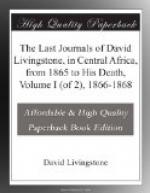9th December, 1866.—A poor child, whose mother had died, was unprovided for; no one not a relative will nurse another’s child. It called out piteously for its mother by name, and the women (like the servants in the case of the poet Cowper when a child), said, “She is coming.” I gave it a piece of bread, but it was too far gone, and is dead to-day.
An alarm of Mazitu sent all the villagers up the sides of Mparawe this morning. The affair was a chase of a hyaena, but everything is Mazitu! The Babisa came here, but were surrounded and nearly all cut off. Muasi was so eager to be off with a party to return the attack on the Mazitu, that, when deputed by the headman to give us a guide, he got the man to turn at the first village, so we had to go on without guides, and made about due north.
11th December, 1866.—We are now detained in the forest, at a place called Chonde Forest, by set-in rains. It rains every day, and generally in the afternoon; but the country is not wetted till the “set-in” rains commence; the cracks in the soil then fill up and everything rushes up with astonishing rapidity; the grass is quite crisp and soft. After the fine-grained schist, we came on granite with large flakes of talc in it. This forest is of good-sized trees, many of them mopane. The birds now make much melody and noise—all intent on building.
12th December, 1866.—Across an undulating forest country north we got a man to show us the way, if a pathless forest can so be called. We used a game-path as long as it ran north, but left it when it deviated, and rested under a baobab-tree with a marabou’s nest—a bundle of sticks on a branch; the young ones uttered a hard chuck, chuck, when the old ones flew over them. A sun-bird, with bright scarlet throat and breast, had its nest on another branch, it was formed like the weaver’s nest, but without a tube. I observed the dam picking out insects from the bark and leaves of the baobab, keeping on the wing the while: it would thus appear to be insectivorous as well as a honey-bibber. Much spoor of elands, zebras, gnus, kamas, pallahs, buffaloes, reed-bucks, with tsetse, their parasites.
13th December, 1866.—Reached the Tokosusi, which is said to rise at Nombe Rume, about twenty yards wide and knee deep, swollen by the rains: it had left a cake of black tenacious mud on its banks. Here I got a pallah antelope, and a very strange flower called “katende,” which was a whorl of seventy-two flowers sprung from a flat, round root; but it cannot be described. Our guide would have crossed the Tokosusi, which was running north-west to join the Loangwa, and then gone to that river; but always when we have any difficulty the “lazies” exhibit themselves. We had no grain; and three remained behind spending four hours at what we did in an hour and a quarter. Our guide became tired and turned, not before securing another; but he would not go over the Loangwa; no one likes to go out of




